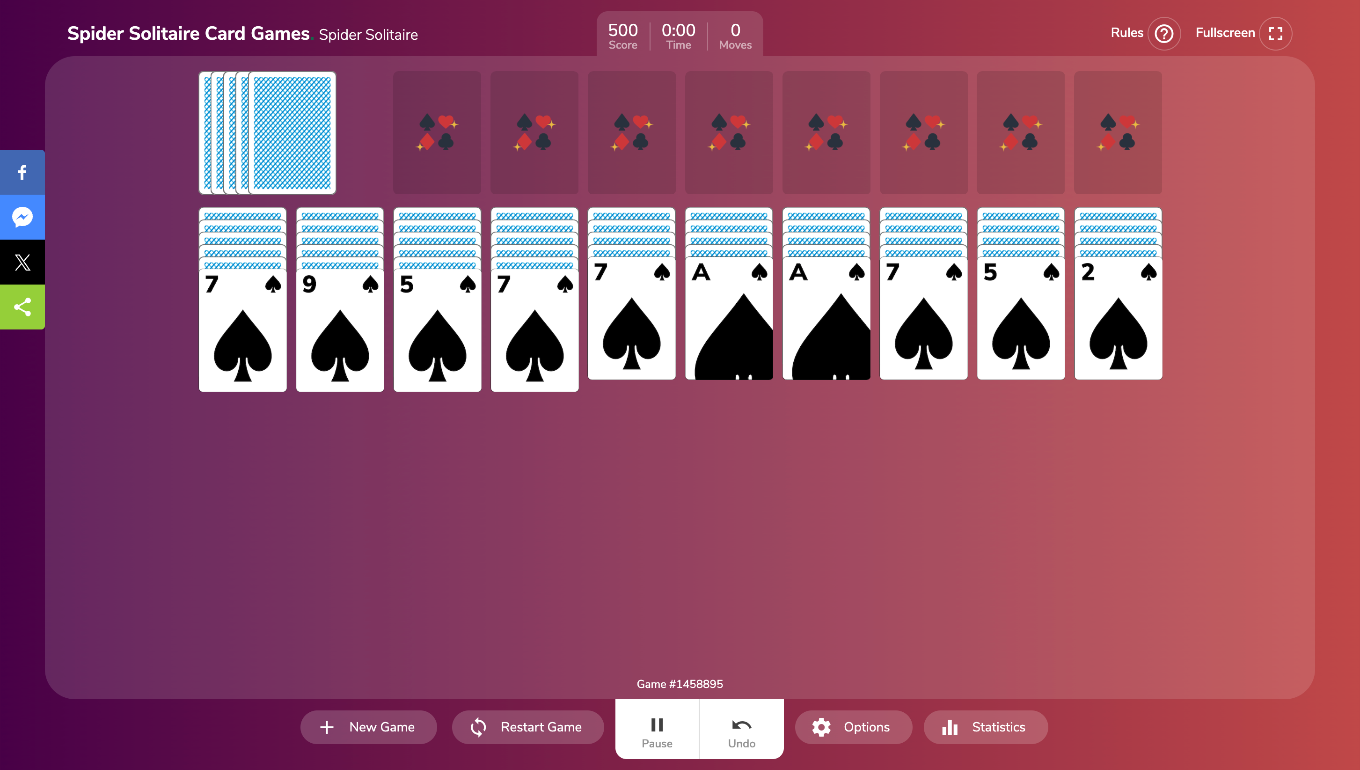SPIDER SOLITAIRE CARD GAMES

Frequently Asked Questions
-
How do you play Spider Solitaire?
Spider Solitaire is played with 104 cards arranged in 10 columns. Move cards in descending order to build sequences from King to Ace in the same suit. Complete all 8 sequences to win. You can move any card onto a card one rank higher, but only same-suit sequences move together as a group.
-
What are the different difficulty levels?
Spider Solitaire offers three difficulty levels: 1 Suit (easiest, 52% win rate using only Spades), 2 Suits (medium, 17% win rate using Spades and Hearts), and 4 Suits (hardest, 6% win rate using all four suits). Start with 1 Suit to learn the mechanics, then progress to higher difficulties.
-
Is Spider Solitaire free to play?
Yes, Spider Solitaire is completely free to play online. No downloads, installations, or registration required. Simply visit the website and start playing instantly in your browser on desktop or mobile devices. Enjoy unlimited games without any cost.
-
Why is it called Spider Solitaire?
The game is named after spiders, which have 8 legs, corresponding to the 8 foundation piles you must complete to win. Each foundation pile represents one leg of the spider. The name perfectly symbolizes the game's objective and structure.
-
Can you move multiple cards at once?
Yes, but only if they form a same-suit sequence in descending order. For example, you can move 9♠, 8♠, 7♠ together as a unit. However, mixed-suit cards like 9♠, 8♥, 7♠ cannot move together - only the top card can be moved individually until the sequence is broken.
-
What happens when you run out of moves?
When no more moves are available in the tableau, you can deal 10 new cards from the stock pile (one card to each column). However, all columns must contain at least one card before you can deal. Fill any empty columns before dealing from stock.
-
Are all Spider Solitaire games winnable?
No, not all Spider Solitaire games can be won. The win rate depends on difficulty: 1 Suit has about 52% winnable games, 2 Suits around 17%, and 4 Suits only 6%. However, good strategy significantly improves your chances of winning solvable games.
-
What's the best strategy for winning?
Key strategies include: reveal face-down cards as quickly as possible, create and preserve empty columns, build same-suit sequences whenever possible, move higher-ranking cards to empty columns, think several moves ahead, and delay dealing from stock until necessary. Practice these techniques to improve your win rate.
-
Can you undo moves in Spider Solitaire?
Yes, most online versions include an undo button that lets you reverse moves and try different approaches. Use this feature to experiment with various strategies, test different move sequences, and learn from mistakes without penalty. Undoing moves is a valuable learning tool.
-
How is Spider Solitaire different from regular Solitaire?
Spider Solitaire uses two decks (104 cards) in 10 columns and requires building 8 same-suit sequences from King to Ace. Regular Solitaire (Klondike) uses one deck (52 cards) in 7 columns and builds 4 foundation piles from Ace to King in alternating colors. Spider emphasizes same-suit building and offers multiple difficulty levels.
-
Does Spider Solitaire improve brain function?
Yes, playing Spider Solitaire can enhance cognitive skills including strategic planning, pattern recognition, memory, problem-solving, and decision-making. The game requires concentration and forward thinking, providing excellent mental exercise while being enjoyable and relaxing.
-
What's the difference between Spider Solitaire and Spiderette?
Spiderette is played with one deck (52 cards) in a 7-column layout similar to Klondike, while Spider Solitaire uses two decks (104 cards) in a 10-column layout. Both require building same-suit sequences, but Spider Solitaire offers a longer, more complex gameplay experience.

